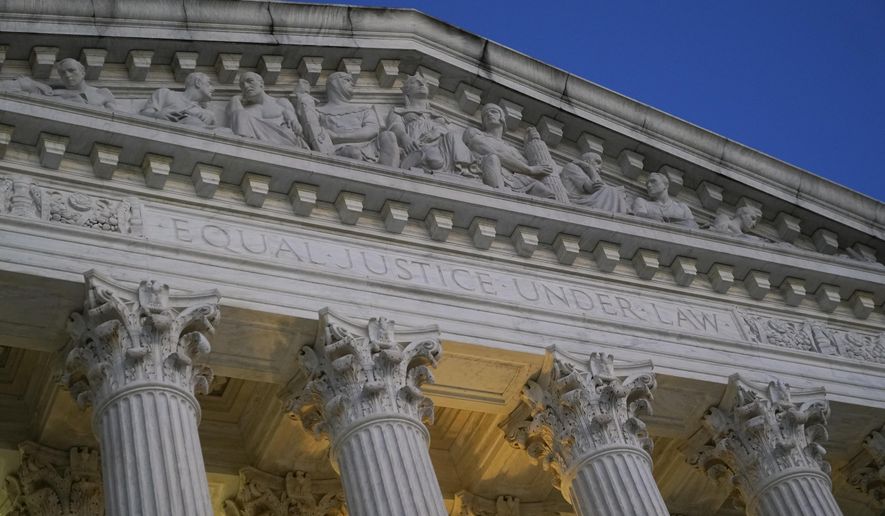It was in the 1970s when the Supreme Court first looked at whether religious employees could be forced to work on their Sabbath.
Thomas Jefferson’s theory of a “wall of separation” between church and state was the dominant legal view, and the justices cast a skeptical eye on the religious request — in that case by airline employees — wondering why their need to pray on a Sunday was more important than a fellow worker’s desire to watch their children’s football game.
The issue returns Tuesday to the high court, with a much different lay of the land. Jefferson’s wall of separation has been breached, and a majority of justices believe their predecessors’ attempt at neutrality turned into outright hostility toward the faithful.
The tension between the approaches springs from the First Amendment’s religion clauses, which bar the “establishment” of religion even as they guarantee the free exercise of worship.
“The major shift in the Roberts court has been a rejection of any kind of separationist doctrine with regard to the establishment clause and a heightened attention to the importance of free exercise,” said Robert Tuttle, a law professor at George Washington University who specializes in religion.
The case before the justices involves Gerald Groff, a mail carrier who celebrates the Sabbath and asked the U.S. Postal Service to make sure he had Sundays off work.
When the Postal Service began delivering Amazon packages on Sundays, his request became tougher to accommodate. Supervisors told Mr. Groff that he would have to pick up some Sunday shifts.
Mr. Groff didn’t show up for at least 24 Sundays. He was punished and eventually left the job.
He sued under Title VII of the Civil Rights Act of 1964, which prohibits employment discrimination based on several categories, including religion.
A federal district judge, and later the 3rd U.S. Circuit Court of Appeals, backed the Postal Service.
They cited the Supreme Court’s 1977 Hardison decision. The court ruled that Trans World Airlines didn’t have to accommodate an employee’s religious beliefs if it involved more than de minimis cost.
Hardison was among a succession of cases that scholars labeled “separationist” because they ascribed to the “wall of separation” concept.
A 1947 case, Everson v. Board of Education, was the first to suggest the wall, citing Jefferson’s words in an 1802 letter. A series of 1960s cases upended prayer and Bible reading in schools.
A 1971 case produced the unfortunately named “Lemon” test for determining when the government had become too entangled. In 1973 and 1975 rulings, the court ruled against state support for tuition or books at religious schools. A 1980 decision struck down a Kentucky law mandating the display of the Ten Commandments. A 1986 ruling allowed the military to bar religious designations, such as a yarmulke, for service members in uniform. A 1990 case found that states could deny unemployment benefits to American Indians fired because of their religious use of peyote, an illegal drug.
By then, however, cracks were showing. Rulings upheld a different tuition support scheme for religious schools and approved a Christmas Nativity display at a public building in specific contexts.
In recent years, the court has allowed a giant Latin cross to remain on public lands, ruled that religious entities can’t be denied access to government money based solely on religious affiliation and approved a teacher’s own prayers at a school event.
Those last two cases were handed down in June. One included a declaration that the Lemon test had been “abandoned.”
David Schultz, a law professor at Hamline University in Minnesota, said the turning point was the 1989 case of the Nativity scene.
“What has happened over time is that the court, and especially now under Roberts, has shrunk the notions of establishment and coercion,” Mr. Schultz said. “Over time, Justices such as [Clarence] Thomas have come to see establishment as only including official state religion whereas coercion is narrowly defined to only involve real compulsion.”
Mr. Schultz said the focus of the right has shifted from the person feeling compelled to the speaker wishing to use religious liberty.
He said he expects the court to push deeper.
He figures that the court will eventually overturn the American Indian peyote case, which drew lines between religious practice and illegal conduct, and will continue to narrow instances where prayer is forbidden in schools. That could include a case in which a teacher is allowed to start class with a prayer and students are free to join.
“Using the free exercise clause as a trump over the establishment clause is where the court is headed,” Mr. Schultz said.
Mr. Tuttle also figures the peyote decision is in the court’s sights.
He said the Groff case seems to present a more limited question, dealing chiefly with the language of Title VII of the Civil Rights Act and whether the precedent in the TWA case accurately summed up a business’ burdens.
The Postal Service, which the Justice Department represents, said the burden goes beyond the business and includes other workers who must fill in for a Sabbath observer.
“This was not a hypothetical burden. This was a real burden on other people,” Mr. Tuttle said. “There were discrete people who had to shoulder the burden of the employee who requests an accommodation.”
An airline industry group underscored that point in a brief in the case. It warned that upending the 1977 precedent could ruin the seniority system that airlines have established in their collective bargaining agreements. The seniority system is the reason airlines can run 24/7 schedules 365 days of the year, Airlines for America told the justices.
Mr. Tuttle said Congress has repeatedly revisited Title VII language and has never sought to meddle with the high court’s standards set in the Hardison precedent.
“The question is why the court needs to do that now,” Mr. Tuttle said.
• Stephen Dinan can be reached at sdinan@washingtontimes.com.




Please read our comment policy before commenting.